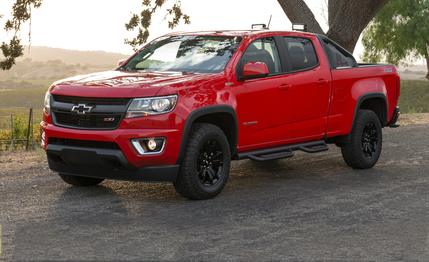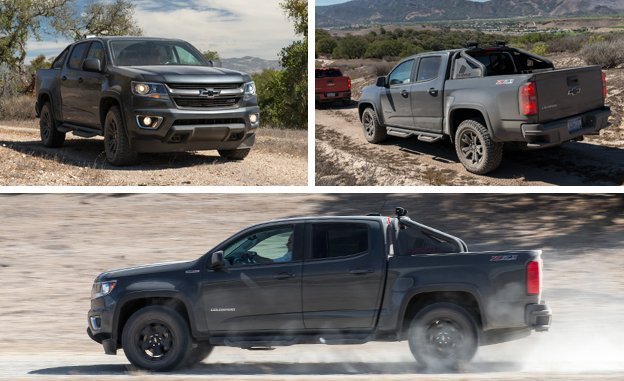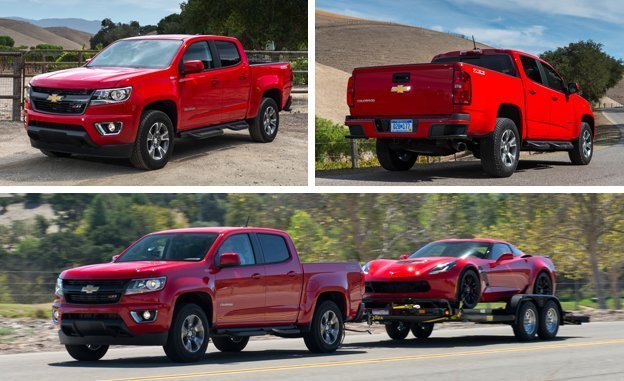 First Drive Review
First Drive Review
Here’s the rundown on Chevy’s new 2016 Colorado diesel: Its new Duramax turbo-diesel engine is made in Thailand, the transmission is assembled in Mexico, there’s plenty of Brazil in the basic design, Chevrolet is a French name, the whole thing is assembled in Missouri, and you’ll need at least $3730 additional American dollars if you want one instead of a gasoline-fired version of this compact truck. And if you like trucks, you’ll want one.
Introduced last year, the latest Colorado and its near-twin, the GMC Canyon, have reinvigorated the seemingly dormant mid-size (or compact or whatever) market. No mere rerun of the mediocre product General Motors once plugged into this space, the Colorado’s easygoing manners and sophisticated detailing have been attracting buyers that just 12 months ago would have reflexively bought a big truck. Even GM itself seems surprised at how good the Colorado turned out and how well it has been selling.
With GM’s Wentzville, Missouri, assembly plant already running flat-out, the Duramax diesel version isn’t going to goose production or sales any further. But it effectively stretches the abilities of the Colorado in ways that are a bit unexpected. The big, long-stroke, 16-valve DOHC 2.8-liter Duramax four-cylinder is rated at only 181 horsepower—but it churns up a chunky 369 lb-ft of peak torque at just 2000 rpm. That’s a full 100 lb-ft more than what’s been available with the Colorado’s gasoline V-6. And it’s not far behind the 383 lb-ft Chevy claims for the Silverado 1500’s 5.3-liter V-8, which also needs to spin to 4100 rpm to reach its torque peak. All Duramax versions will be equipped with the same 6L50 six-speed automatic transmission available in other models.
All that torque means that the Colorado Duramax is the best compact truck yet devised for towing duty: The strongest gas-powered model can offer 7000 pounds of towing capacity, whereas a two-wheel-drive diesel is rated to tug up to 7700. Go for the 4x4 diesel and the tow rating drops by 100 pounds, but Airstream’s big, 28-foot Land Yacht travel trailer has a base weight of 6586 pounds, thereby leaving the Colorado Duramax owner at least half a ton of room to add options, water, and cargo like 1200-thread-count sheets. And without the turbo-diesel’s deep well of low-end torque, the gasoline models won’t be as comfortable towing any size load.

While torque production is the Duramax four’s greatest talent, it’s the engine’s refinement that makes it easy to live with. Based around a tall iron block, it features a pair of counter-rotating steel balance shafts in the oil sump that knock out much of the vibration inherent in such a gnarly beast. Add hydraulic engine mounts and there’s little—albeit not none—of the rocking motion at idle once common with diesel truck engines.
To further civilize things, a “Centrifugal Pendulum Vibration Absorber” has been embedded inside the transmission’s torque converter. According to the Chevrolet, “the CPVA is an absorbing damper with a set of secondary spring masses, that—when energized—cancels out the engine’s torsional vibrations.” Okay, we look forward to the SAE white paper. Finally, to isolate diesel noises out of the cabin, GM has added sound-deadening material to the Colorado’s dashboard area and thickened the pads in other areas. This is an exceptionally quiet diesel when you’re inside with the windows up.
Driving an unladen Colorado Duramax 4x4 along California’s central coast, it’s the quiet and refinement that impresses the most initially. The engine rarely operates at speeds over 2000 rpm, and the transmission is just as poised here as it is when it’s lashed to a gas engine. Unless the driver is staring at the tachometer, or obsessed with ultimate acceleration numbers, there’s little to indicate that this Colorado is burning diesel fuel.

According to Chevrolet, the Duramax adds about 440 pounds to the Colorado’s curb weight compared with the standard 2.5-liter gasoline four-cylinder. That’s about 270 more than the V-6. Since practically all the additional weight is on the nose, there’s some slight increase in steering effort but that’s about it.
Of course the diesel isn’t as quick as its V-6 brother, but it’s quick enough under most circumstances. There are no EPA fuel-economy ratings available as of yet, but GM has stated a goal of 30 mpg highway for the Colorado diesel.
While towing a 4000-pound horse trailer that GM just happened to have lying around, the diesel found its voice. The engine is not very loud, but the clatter of the engine’s compression ignition is apparent. It’s not a bad sound and may in fact be reassuring to some owners as sounding the way a diesel should. But it’s definitely there. What’s also there is an integrated exhaust brake, a device also known as a “Jake Brake,” that uses engine exhaust pressure to regulate downhill speed without over-reliance on the four-wheel disc brakes.
The Colorado Duramax is civilized enough to drive every day and small enough to fit in most garages, and it carries a friendly sticker price as far as diesel trucks go (although Ram offers its EcoDiesel V-6 in the full-size 1500 for about $32K). And there’s never been a truck in this size class so clearly focused on towing ability. The main downside is that availability is restricted to short- and long-bed Crew Cab LT and Z71 models; the Extended Cab remains gas-only. Still, Chevrolet is likely to be limited in how many it can sell solely by how many it can make.